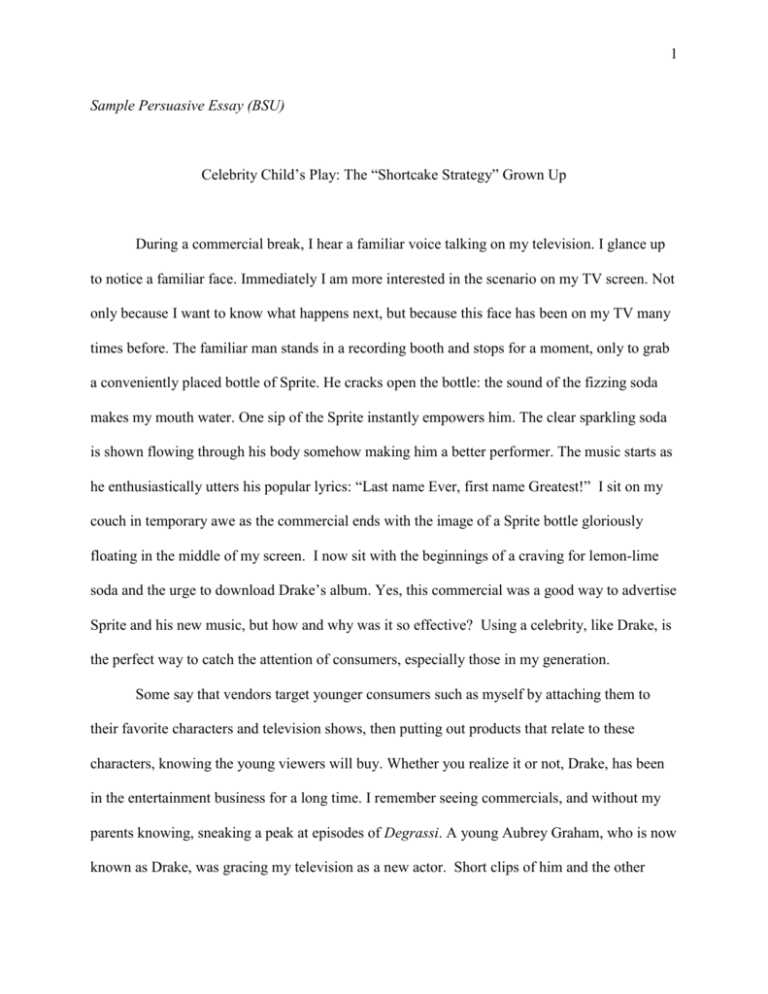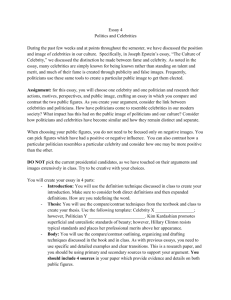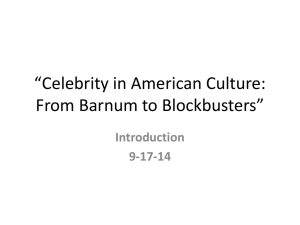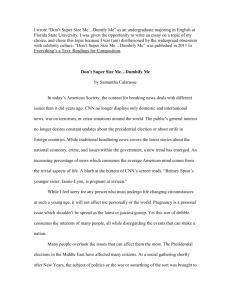1 Sample Persuasive Essay
advertisement

1 Sample Persuasive Essay (BSU) Celebrity Child’s Play: The “Shortcake Strategy” Grown Up During a commercial break, I hear a familiar voice talking on my television. I glance up to notice a familiar face. Immediately I am more interested in the scenario on my TV screen. Not only because I want to know what happens next, but because this face has been on my TV many times before. The familiar man stands in a recording booth and stops for a moment, only to grab a conveniently placed bottle of Sprite. He cracks open the bottle: the sound of the fizzing soda makes my mouth water. One sip of the Sprite instantly empowers him. The clear sparkling soda is shown flowing through his body somehow making him a better performer. The music starts as he enthusiastically utters his popular lyrics: “Last name Ever, first name Greatest!” I sit on my couch in temporary awe as the commercial ends with the image of a Sprite bottle gloriously floating in the middle of my screen. I now sit with the beginnings of a craving for lemon-lime soda and the urge to download Drake’s album. Yes, this commercial was a good way to advertise Sprite and his new music, but how and why was it so effective? Using a celebrity, like Drake, is the perfect way to catch the attention of consumers, especially those in my generation. Some say that vendors target younger consumers such as myself by attaching them to their favorite characters and television shows, then putting out products that relate to these characters, knowing the young viewers will buy. Whether you realize it or not, Drake, has been in the entertainment business for a long time. I remember seeing commercials, and without my parents knowing, sneaking a peak at episodes of Degrassi. A young Aubrey Graham, who is now known as Drake, was gracing my television as a new actor. Short clips of him and the other 2 actors behind the scenes showed their everyday lives and made viewers, like me, feel that they knew these teenaged celebrities personally. It’s understandable that someone my age is captivated when a celebrity as successful as Drake is supporting a product like Sprite or releasing a new album. Like supporting an old friend, people who have watched Mr. Graham from the time he was sixteen will take an interest in what he is advertising. This method is technically known as the “Shortcake Strategy.” Thousands of girls buying Hannah Montana dolls and wearing t-shirts with Miley Cyrus’ face plastered on them is the perfect example of this. But what most people don’t realize is that this same method is being used to influence buyers of all ages, not just my contemporaries. Companies and advertisers treat adults like children, making sure they feel emotionally attached to their favorite celebrities before trying to sell them anything, which usually results in them buying anything that these celebrities endorse. The best salesman is one who can get the buyer to trust them. Many consumers may say this isn’t true. They say they are too mature and are not affected by advertisements. But, these same naysayers have most likely seen a movie because their favorite actor was in it, or have bought an album because they have been listening to the same artists for years. The consumers who participate in these things do so because they are somehow attached to these celebrities. A person doesn’t say his or her favorite actor is Brad Pitt unless they have a history of watching his movies. This history would probably consist of the fan watching several movies starring Brad Pitt, getting to know his acting style, and even memorizing a few quotes from different movies. All of this results in a viewer being attached to this particular actor. So, as an avid fan, if Brad Pitt were to appear on television advertising a certain product, the viewer would most likely consider checking out this item. 3 Think about it. Why do celebrities want you to know their life stories? Have you ever noticed some of the most popular celebrities have told stories about their childhood at one point? It can be so obvious that it is sometimes overlooked. Do they really care if their fans know about what happened to them at the age of five? I believe this is one of the many ways celebrities and advertisers get fans and buyers to attach to celebrities emotionally. Explaining the hardships and emotions of a certain celebrity can make them appear to be a real, more relatable person to consumers. Recording artist Taylor Swift for example, has a story of success that every stereotypical dorky teenager can relate to. Before the release of her album, Fearless, Taylor Swift seemed to be on every talk-show displaying old home videos and re-living the story of her high school years. Audiences were and still are constantly being reminded of how sweet the tall blonde is and how she overcame being bullied in high school. To teenaged girls everywhere, Swift is a role model- a hero, even. They can not only relate to her, some even want to be her: to be able to say what they feel, stand up to bullies and show those bullies there is more to them than their “dorky” appearance. Just like ten year old boys want to be able to fly, have x-ray vision and super strength like Superman. The only difference being, an eighteen year old girl will go out and buy Taylor Swift’s album, while a ten year old boy will beg his mom to buy him a Superman action figure and pajamas for his birthday. In both situations, consumers are convinced by the respective advertisements to go out and purchase the advertised products. So, the fact that Taylor Swift is a good song writer and a decent singer isn’t the only reason why she sold millions of albums. If you haven’t caught on by now maybe you don’t understand exactly what the “Shortcake Strategy” is. The Shortcake Strategy is a marketing tool that is usually used on children. The method got its name from the popular cartoon character Strawberry Shortcake. In 4 the article “Me Against the Media: From the Trenches of a Media Lit Class” by Naomi RocklerGladen she explains in her own words how the Shortcake Strategy began. Tom Engelhardt defines the “‘Shortcake Strategy’- [as a concept through] … which children’s TV shows were created for the exclusive purpose of marketing large collections of children’s toys” (RocklerGladen 287). Some do not realize this, but Strawberry Shortcake was not originally a Saturday morning cartoon. Shortcake and her friends were created by American Greetings to sell cards. After the show was created, customers would buy the cards simply because they recognized the characters from the television show. Just as when people of a younger generation notice a Sprite product and the Drake lyrics pop into their head, there are probably millions of people of the 1980’s who sing “Straw-ba-ba-ba-ba-berry!” when they notice the little girl’s face on a greeting card. Joy Tashjian and Naidoo Campbell, who wrote "Licensing and Merchandising in Children's Televion and Media," which is published in the book The Children’s Television Community, explain how far this strategy has come. “From toys, clothing, books, video games to toothbrushes, bubble bath, cereal, and snack foods, store shelves are overflowing with products prominently featuring children’s television and cartoon characters” (Tashjian and Campbell165). In 1987, when the concept of advertising to children via popular shows was new, author Cy Schneider released his book titled Children’s Television. He states, “New children’s characters are no longer originated by television or movies. Instead they are originated by toy companies as products, and then turned into television shows” (Schneider 111). Once the producers of a toy realize their product is selling well, they create a show with a plot and new characters to boost the sales even higher. Or vice versa, a popular show can be turned into an even more popular line of toys. Schneider goes on to explain more of the sales strategy, “The Theory behind these new 5 shows is that young viewers have already been attracted to the characters in toy form, and will therefore be attracted to the programs. Conversely, the programs help boost retail sales of the existing and new products in these brands categories” (Schneider 112). This is the equivalent to celebrities creating a success story for their audience. The celebrity not unlike the toy is seen as popular and admired by their fans. Then, similar to a television program, they come out with a story from their past that people can relate to. Just as the television program helps sell toys, the success story helps boost the sales of albums, movies or whatever the celebrity is endorsing. So when Kate Hudson discusses her pregnancy with the hosts of E! News and then within each commercial break we see her in an Almay commercial endorsing makeup, perhaps viewers should stop and think about why Hudson is doing this. Does she really care if we as viewers know about her future child? Or is it a part of “the program” used to make the audience and buyers like the toy more? The more the audience likes the celebrity, the more sales this celebrity will produce. Realizing this, companies will hire actresses such as Kate Hudson or Hip-Hop artists as popular as Drake to make what some may call an endorsement deal. Not only do the celebrities know that connecting to their audience will get them to buy their products, but big companies similar to Nike know this as well. They know that an athlete like David Beckham, who is respected and well known, can help them heighten sales. In the article “Risks and Rewards of Celebrity Endorsements,” Anita Elberse explains how much a celebrity can affect a company’s sales. “[S]ales for brands in a variety of consumer-product categories jumped an average of 4 percent in the six months following the start of an endorsement deal, even after controlling for advertising expenditures and other factors that could be expected to drive up sales. Several brands saw sales rise with more than 20 percent after teaming up with an endorser.” 6 Now back to Taylor Swift. Since there is not a person in the world who does not like Swift, she can use her talent to not only advertise and sell her own work, but also help other companies be recognized as well. Along with her fellow celebrities, Swift has been in several commercials over the past few years. She has been seen endorsing several different products from video games, cameras, makeup to big name corporations such as Target. Companies like Target realize that someone as personable as Taylor Swift will catch the attention of viewers using her charisma and charm to win them over and convince them to shop at their local Target. The recent Covergirl “Natureluxe” commercials show Swift encouraging viewers to buy Covergirl’s new products. With a perfect made up face she explains the product as she gracefully frolics through sheer linens. Although it should be clear to the viewer that her words are very scripted and that wearing the new makeup will most likely not make them look anything like Swift, nor will it result in them doing pirouettes through sheer fabric, viewers still buy into it. The same people who like Taylor enough to buy her album are probably in the check-out line at their favorite Target (because Target has made consumers believe Taylor Swift shops there), buying the new “Natureluxe” makeup. It is the same case with the other Cover Girls, Queen Latifah, Drew Barrymore, and Rihanna all relating to a different audience and all persuading them, in a typical scripted commercial way to be, “Easy Breezy, Beautiful.” Consumers should not overlook the fact that celebrities, advertisers, and companies are working together to draw them in by influencing their emotions. Some may feel they cannot be affected by these sale methods, and that they are only used on children, when the reality is that advertisers can find a way to relate to anyone that is willing to listen. Like children, we will create memories with different celebrities through their music, movies and other works resulting 7 in an emotional response while they are trying to convince us to buy something. There is a reason why they are our favorite celebrities, and as fans we are willing to support them. Works Cited Tashjian, Joy and Campbell, Naidoo. "Licensing and Merchandising in Children's Televion and Media." Bryant, J. Alison. The Children's Television Community. Mahwah, NJ: Lawrence Erlbaum, 2007. Print. 165-188. Elberse, Anita. "Risks and Rewards of Celebrity Endorsements." CNN. 16 Dec. 2009. Web. Apr. 2011. <http://articles.cnn.com/200916/opinion/elberse.athlete.endorsements.tiger.woods _1_endorsers-celebrity-brands?_s=PM:OPINION>. Rockler-Gladen, Naomi. "Me Against the Media: From the Trenches of a Media Lit Class." Graff, Gerald, Cathy Birkenstein, and Russel K. Durst. "They Say/I Say": the Moves That Matter in Academic Writing: with Readings. New York: Norton, 2009. Print. Schneider, Cy. "The Licensed Character- Today's Hottest Salesman." Children's Television: the Art, the Business, and How It Works. Lincolnwood, Ill.: NTC Business, 1987. Print.







